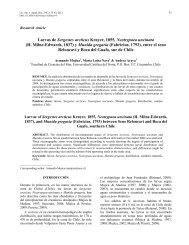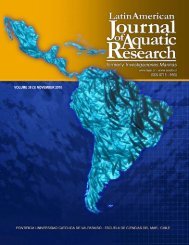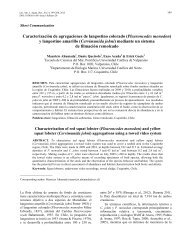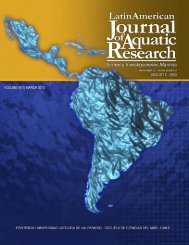s - Latin American Journal of Aquatic Research
s - Latin American Journal of Aquatic Research
s - Latin American Journal of Aquatic Research
Create successful ePaper yourself
Turn your PDF publications into a flip-book with our unique Google optimized e-Paper software.
Lat. Am. J. Aquat. Res., 37(3): 281-284, 2009<br />
“Deep-sea fisheries <strong>of</strong>f <strong>Latin</strong> America”<br />
P. Arana, J.A.A. Perez & P.R. Pezzuto (eds.)<br />
DOI: 10.3856/vol37-issue3-fulltext-1<br />
Deep-sea fisheries <strong>of</strong>f <strong>Latin</strong> America: an introduction<br />
Deep-sea fisheries <strong>of</strong>f <strong>Latin</strong> America: an introduction<br />
Patricio Arana 1 , José Angel Alvarez Perez 2 & Paulo Ricardo Pezzuto 2<br />
1 Escuela de Ciencias del Mar, Pontificia Universidad Católica de Valparaíso<br />
P.O. Box 1020, Valparaíso, Chile<br />
2 Centro de Ciências Tecnológicas da Terra e do Mar, Universidade do Vale do Itajaí<br />
Rua Uruguai 458, Centro, Itajaí, SC, Brazil<br />
Recent assessments <strong>of</strong> the state <strong>of</strong> the world’s marine<br />
capture fisheries demonstrate that global catches have<br />
attained (or surpassed) maximum sustainable levels in<br />
the last two decades (Pauly et al., 2002). These reports<br />
also point out three critically related global trends: (a)<br />
fishing efforts in developing countries have increased<br />
in order to meet the high demands <strong>of</strong> the “overfished”<br />
developed world (Garcia & Grainger, 2005; Pauly et<br />
al., 2005), (b) catches have concentrated on smaller<br />
organisms <strong>of</strong> lower trophic levels (Pauly et al., 1998),<br />
and (c) fishing has gone deeper (Morato et al., 2006). It<br />
has been argued that developing coastal countries,<br />
concentrated in the Southern Hemisphere, have developed<br />
their <strong>of</strong>fshore fishing capacity (through national<br />
fleet enhancement or foreign fishing agreements) in<br />
order to further production <strong>of</strong> both large, high-value<br />
and small, low-value fish (and shellfish); the former<br />
are destined for international markets and the latter to<br />
supply domestic food demands. Worldwide, this process<br />
has also been associated with the progressive occupation<br />
<strong>of</strong> deeper areas by commercial fleets, initially in<br />
search <strong>of</strong> better catches <strong>of</strong> shelf targets but eventually<br />
aiming at the exploitation <strong>of</strong> some highly pr<strong>of</strong>itable,<br />
typically deep-water species (Japp & Wilkinson,<br />
2007).<br />
Largely embedded in the developing world, <strong>Latin</strong><br />
America may be seen as a good example <strong>of</strong> such<br />
trends. It comprises 20 coastal countries whose Economic<br />
Exclusive Zones (EEZs) extend into the southwestern<br />
Atlantic, eastern Pacific, Southern Oceans, and<br />
Caribbean Sea. The region has historically contributed<br />
over 15% the world’s marine fish production, although<br />
most <strong>of</strong> this has concentrated on fishmeal produced by<br />
massive catches <strong>of</strong> small pelagic fish in upwelling<br />
zones <strong>of</strong>f Peru and Chile. In recent decades, however,<br />
<strong>Latin</strong> <strong>American</strong> fisheries production not only increased<br />
continuously but also diversified, shifting its focus to<br />
the production <strong>of</strong> fish for human con-sumption (as<br />
opposed to fishmeal) and trading with the USA, EU,<br />
281<br />
and Japan (Wiefels, 2003). As the new millennium<br />
progressed, <strong>Latin</strong> America became a major net export<br />
region reporting, in 2006, an 8 billion US$ surplus in<br />
fish and the fish products trade (Garcia & Grainger,<br />
2005; FAO, 2009). Notwithstanding, several large<br />
<strong>Latin</strong> <strong>American</strong> countries have also experienced a<br />
growing domestic demand for seafood, and regional<br />
fishery development seems to have been motivated by<br />
obtaining hard currency rather than food security<br />
(Wiefels, 2003). In the context <strong>of</strong> said fishing development<br />
history, it stands to be asked: has fishing also<br />
gone deeper <strong>of</strong>f <strong>Latin</strong> <strong>American</strong> countries?<br />
Deep-water fishing, normally defined as fishing<br />
conducted near the seafloor beyond the continental<br />
shelf break (including slope areas, seamounts, and<br />
seamount ridges), emerged in the 1950s through pioneer<br />
operations <strong>of</strong> Russian trawlers on the northern<br />
mid-Atlantic ridge (Troyanovsky & Lisovsky, 1995;<br />
Japp & Wilkinson, 2007). In the following decades<br />
(1960-2000), fishing technologies advanced and deepwater<br />
fisheries expanded to all oceanic regions <strong>of</strong> the<br />
world, being particularly important in northern temperate-water<br />
oceans (i.e. Northeast Atlantic) (Sissewine &<br />
Mace, 2007). In 2004, over 5.6 million tonnes <strong>of</strong> deepwater<br />
species were reported worldwide; <strong>of</strong> these, 2.4<br />
million (43%) were blue ling (Molva dypterygia)<br />
catches obtained in the northeastern Atlantic along<br />
with other species, including Greenland halibut<br />
(Reinhardtius hippoglossoides), ling (Molva molva),<br />
northern prawn (Pandalus borealis), roundnose grenadier<br />
(Coryphaenoides rupestris), and others. The<br />
southeastern Pacific and southwestern Atlantic, where<br />
most <strong>Latin</strong> <strong>American</strong> countries fish, contributed no<br />
more than 3% <strong>of</strong> global deepwater catches in 2004.<br />
Nevertheless, over 350,000 tonnes <strong>of</strong> total catches<br />
were reported that year <strong>of</strong> Patagonian toothfish (Dissostichus<br />
eleginoides), Patagonian grenadier (Macruronus<br />
magellanicus), the pink cusk-eel (Genypterus<br />
blacodes), and southern blue whiting (Micromesistius







